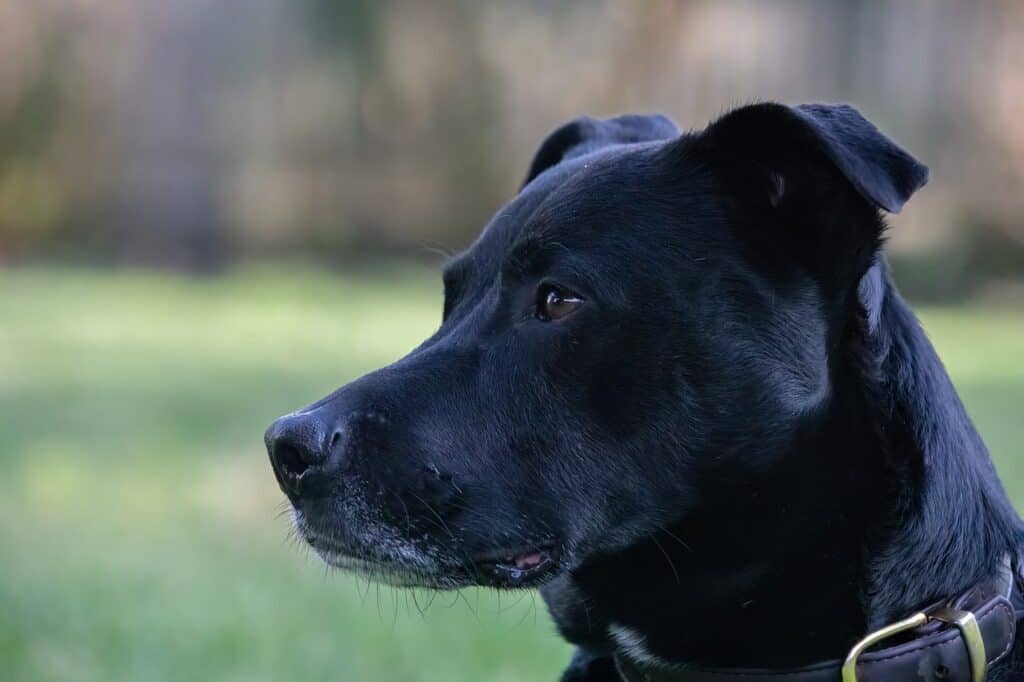The Patterdale Terrier, hailing from the Lake District in England, is a robust and tenacious breed with a strong hunting instinct. Known for its compact size and determination, this terrier is often used for hunting small game. Despite its working background, the Patterdale Terrier makes a loyal and affectionate companion, bringing energy and enthusiasm to households that appreciate its spirited nature and charming personality.

| Category (Explanation) | Breed Information |
|---|---|
| Year of Breed Conception | 20th century |
| Country of Origin | United Kingdom |
| Weight (lbs & kg) (Male) | 11-13 lbs (5-6 kg) |
| Weight (lbs & kg) (Female) | 11-13 lbs (5-6 kg) |
| Coat Type | Short and dense |
| Color Variations | Black, red, liver, brindle, or black and tan |
| Shedding Level (Low, Moderate, High) | Low |
| Height (cm & in) | 10-15 inches (25-38 cm) |
| Breed Size | Small to Medium |
| Trainability (Low, Moderate, High) | Moderate |
| Mental Needs (Low, Moderate, High) | Moderate |
| Intelligence Level (Low, Moderate, High) | Moderate |
| Energy Level (Low, Moderate, High) | High |
| Agility (Low, Moderate, High) | High |
| Loyalty (Low, Moderate, High) | High |
| Playfulness (Low, Moderate, High) | High |
| Exercise Needs | Regular exercise and mental stimulation |
| Guarding Proficiency (Low, Moderate, High) | Moderate |
| Sociability with Children (Low, Moderate, High) | Moderate |
| Barking Level (Low, Moderate, High) | Moderate |
| Digging Tendency (Low, Moderate, High) | High |
| Destructive Behavior (Low, Moderate, High) | Moderate |
| Drooling Level (Low, Moderate, High) | Low |
| Obedience Level (Low, Moderate, High) | Moderate |
| Apartment Friendly (Yes/No) | Yes |
| Inherent Prey Drive | High |
| Physical Risk to Others (Low, Moderate, High) | Low |
| Travel Fatality Risk (Low, Moderate, High) | Low |
| Allergen Potential | Low |
| Health Concerns (List of Common Health Concerns) | No specific common health issues |
| Average Life Expectancy (Life Expectancy in Years) | 11-15 years |
Woof Mastery is reader supported and our articles may contain affiliate links.
Instead of running third party ads that we have no control of we only use links from high-quality companies we are directly partnered with. Making use of these links come at no cost to you our reader, and in many cases have the extra benefit of discounted rates or sign up bonuses.
If you’re interested you can read more about our affiliate policy here.
We appreciate your support and always insure that the products and services we recommend are high-quality, helpful and relevant to the subject at hand!
The Patterdale Terrier, originating from the Lake District in England, has a history deeply connected to its role as a working terrier. Developed for hunting and controlling vermin, this breed showcases determination and versatility in challenging terrains. The Patterdale Terrier’s compact size, coupled with its tenacity and friendly demeanor, has made it a popular choice as both a working dog and a family companion. Its history reflects its resilience and adaptability in fulfilling various roles throughout the years.

The Patterdale Terrier is special for its tenacity and adaptability. Bred for hunting and controlling vermin, this breed showcases determination and versatility in challenging terrains. What sets it apart is its ability to transition seamlessly from a working terrier to a loyal family companion. The Patterdale Terrier’s compact size, coupled with its friendly demeanor, makes it a special addition to households seeking a spirited and affectionate canine friend that effortlessly combines ruggedness with a loving heart.
The Patterdale Terrier’s traditional role is deeply connected to its origins in the Lake District of England, where it was developed for hunting and controlling vermin. Known for its determination and versatility, this terrier excelled in challenging terrains. Its traditional role as a working terrier continues today, with the Patterdale Terrier serving as both a skilled hunter and a loyal family companion. Its compact size, coupled with its friendly demeanor, makes it a valuable addition to households seeking a spirited and affectionate canine friend that effortlessly combines tenacity with a loving heart.
Patterdale Terriers are known for their tenacity and adaptability. Bred for hunting and controlling vermin, they showcase determination and versatility. These terriers are loyal and friendly, often described as spirited and affectionate. Patterdale Terriers transition seamlessly from working roles to loyal family companions. With their compact size and friendly demeanor, they make valuable additions to households seeking a spirited and affectionate canine friend. Despite their working background, they showcase a loving heart and bring joy to those fortunate enough to have them as part of their families.
Patterdale Terriers are known for their tenacity and adaptability. Bred for hunting, they can display determination and courage. With proper training and socialization, they transition seamlessly into loyal family companions. Patterdale Terriers are typically friendly and affectionate with their families. Supervision is recommended around other dogs, and introductions should be handled carefully. Despite their working background, they showcase a loving heart and bring joy to those fortunate enough to have them as part of their families. With consistent positive reinforcement, Patterdale Terriers develop into spirited and well-mannered companions.
Patterdale Terriers are small to medium-sized dogs with a sturdy and well-muscled build. They have a distinct head with a flat skull and a moderate stop. Their eyes are dark and alert, and their ears are small and folded forward. The breed has a dense, wiry coat that comes in various colors, including black, chocolate, red, or tan. Patterdale Terriers have a straight back, a high-set tail, and a brisk, confident gait. They convey a sense of determination, agility, and charm.
Patterdale Terriers come in various color variations, adding to their spirited and charming appearance. The most common color variations for Patterdale Terriers include:
Patterdale Terriers come in various colors, including black, chocolate, red, or tan. While the breed standard does not specifically describe coat patterns, individual Patterdale Terriers can have variations in coat color and markings. The breed’s coat is dense, wiry, and weather-resistant, providing protection during outdoor activities. Patterdale Terriers may have markings or patterns, and their coat color should be rich and well-defined, contributing to their versatile and spirited appearance.
Patterdale Terriers have a low shedding level. Their dense, wiry coat sheds minimally, and regular grooming is important to maintain coat health. Brushing the coat once or twice a week helps remove loose fur and prevents matting. While Patterdale Terriers are not heavy shedders, grooming practices are essential to ensure their coat remains in good condition.
Patterdale Terriers have a dense, wiry coat that requires regular grooming to keep them looking their best. Here are some grooming habits for Patterdale Terriers:
Patterdale Terriers have a high activity level. As working terriers, they are energetic and require regular exercise to stay healthy and happy. Daily walks, playtime, and activities that engage their natural instincts are essential. Patterdale Terriers benefit from mental stimulation through training sessions and interactive toys. Providing a structured routine that includes both physical and mental engagement is crucial for their well-being.
Patterdale Terriers showcase intelligence in their courageous and loyal demeanor. Their ability to problem-solve, coupled with a strong sense of loyalty, makes them adaptable working dogs. Positive reinforcement in training and providing tasks that engage their instincts contribute to their overall intelligence and well-rounded behavior.
Patterdale Terriers require mental stimulation to keep them mentally sharp. Engage them in activities like puzzle toys, interactive games, and training exercises. Social interaction is crucial for their well-being, so regular companionship and attention are important. Obedience training provides mental stimulation and strengthens the bond with their owners. A routine, affection, and a safe environment contribute to their overall mental well-being.
Enter The Woof Mastery

Before bringing a Patterdale Terrier into your home, consider the following:
Patterdale Terriers, known for their courage, may pose a risk if not properly trained and socialized. Early training and consistent socialization can help manage their behavior, ensuring they are comfortable around people and other pets. Owners should be responsible and aware of their dog’s interactions in various settings.
Patterdale Terriers, known for their courage, can be good companions for families with older children. Supervision is important due to their energetic nature. Early socialization and consistent training are crucial to ensure they are well-behaved around children. Their courage and loyalty may make them protective of the family, and proper training can channel their energy positively.
Patterdale Terriers may have mixed responses to water. Some individuals may enjoy swimming, while others may not be as comfortable. If you plan to introduce them to water, do so gradually and observe their comfort level. Always prioritize safety and use a canine life vest if needed.
Remember that Patterdale Terrier puppies, like all puppies, are eager to please and learn. Positive and consistent training practices will help them become well-behaved, obedient, and happy adult dogs. Building a strong and trusting bond with your puppy through training is a rewarding experience for both you and your canine companion.
Patterdale Terriers may bark, especially if they are stimulated or alert. As with many terrier breeds, training and socialization are essential to prevent excessive barking. Positive reinforcement methods can be effective in shaping their behavior.
Patterdale Terriers thrive in homes with active owners who can provide regular exercise and play. They are adaptable to various living conditions, including apartments, but they need mental stimulation. Socialization is important to prevent aggression. Positive reinforcement training is effective in shaping their behavior.
Traveling with Patterdale Terriers involves considerations for their size and activity levels. Use a secure travel crate or restraint for their safety. Plan for breaks during the journey to address their energy levels and provide bathroom breaks. Address any potential anxiety through positive associations with travel and familiar items. Choose airlines with policies suitable for small breeds if flying and comply with crate requirements for air travel safety.
Patterdale Terriers, like all breeds, may be prone to specific health concerns. While not all individuals will experience these issues, it’s crucial for Patterdale Terrier owners to be aware of potential health risks and work with veterinarians to maintain their pets’ well-being. Common health risks in Patterdale Terriers include:
Owners should prioritize regular veterinary check-ups, preventive care, and a balanced diet to support the health and well-being of Patterdale Terriers.
Proper nutrition is crucial for the health and well-being of Patterdale Terriers. Here are some nutritional habits and best practices to consider for this breed:
Breed-Specific Laws (BSL): Patterdale Terriers may be subject to breed-specific laws (BSL) in certain areas. These laws are often enacted at the local or municipal level and can vary widely from one jurisdiction to another.
Types of Restrictions: The specific restrictions imposed on Patterdale Terriers under BSL can include mandatory spaying/neutering, special licensing, liability insurance requirements, muzzling in public, and, in some cases, bans on ownership. The severity of these restrictions depends on local regulations.
Rationale for BSL: BSL is typically implemented based on concerns about public safety and perceived risks associated with specific breeds, often due to incidents involving dog attacks. While Patterdale Terriers are not inherently aggressive, they can be affected by BSL due to their physical resemblance to breeds that are sometimes included in these laws.
Controversy: It’s important to note that BSL is a controversial topic. Critics argue that it unfairly targets breeds rather than addressing individual dog behavior and that responsible ownership and training should be emphasized instead of breed-specific restrictions.
Local Regulations: To determine if there are breed-specific laws or restrictions regarding Patterdale Terriers in your area, you should check with your local animal control or government authorities. Be aware of and comply with any local regulations to ensure that you are in compliance with the law while owning a Patterdale Terrier.
Woof Mastery is reader supported and our articles may contain affiliate links.
Instead of running third party ads that we have no control of we only use links from high-quality companies we are directly partnered with. Making use of these links come at no cost to you our reader, and in many cases have the extra benefit of discounted rates or sign up bonuses.
If you’re interested you can read more about our affiliate policy here.
We appreciate your support and always insure that the products and services we recommend are high-quality, helpful and relevant to the subject at hand!
Myth 1: Patterdale Terriers are Aggressive Towards People
Myth 2: They Need Constant Exercise
Myth 3: They are Only Suitable for Experienced Owners
Myth 4: They are All the Same
Myth 5: They Don’t Get Along with Other Pets
Myth 6: They are Difficult to Groom
Myth 7: They are Not Good with Children
Myth 8: They are Prone to Excessive Barking
Myth 9: They Cannot Adapt to Indoor Living
Myth 10: They are Not Intelligent
These myths underscore the importance of understanding the unique characteristics of Patterdale Terriers and addressing their needs through responsible ownership and care.
Famous Patterdale Terrier examples are not as widely documented, but these bold and energetic dogs can be found as working dogs in various roles such as hunting and farm work.
The Patterdale Terrier holds cultural significance as a bold and energetic working dog. Originating in the Lake District of England, Patterdales are recognized for their tenacity in various roles, including hunting and farm work. Their appearance in rural communities and their loyal nature contribute to their cultural importance. Patterdale Terriers are symbols of resilience and work ethic, finding appreciation among those who value their versatile capabilities and companionship.
The Patterdale Terrier holds cultural significance as a bold and energetic working dog. Originating in the Lake District of England, Patterdales are recognized for their tenacity in various roles, including hunting and farm work. Their appearance in rural communities and their loyal nature contribute to their cultural importance. Patterdale Terriers are symbols of resilience and work ethic, finding appreciation among those who value their versatile capabilities and companionship.
Patterdale Terriers, like many terrier breeds, have faced specific challenges and considerations. Some of the notable challenges include:
The Patterdale Terrier is a working terrier breed developed in England. Contributing breeds may include:
Patterdale Terriers, with their robust and determined demeanor, make excellent companions for individuals or families seeking an active and spirited pet. Known for their agility and hunting instincts, they thrive in environments that provide mental and physical challenges. Their adaptability to various living conditions allows them to fit seamlessly into urban and suburban settings. Engaging in activities that cater to their energetic nature and providing them with opportunities for interaction strengthens the unique bond they share with their families, making them cherished members of the household.